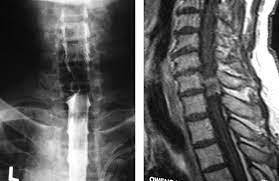Dr. Paresh Bang | Matruchhaya Spine Clinic
Meet Our Doctor
Dr. Paresh Bang
Consultant Spine Surgeon

Surgery for cervical myelopathy In Adilabad

Surgery for cervical myelopathy
Surgery for cervical myelopathy is aimed at relieving pressure on the spinal cord in the neck region (cervical spine) to prevent further neurological damage and potentially restore some function. Cervical myelopathy occurs when there is compression of the spinal cord due to conditions like spinal stenosis, herniated discs, bone spurs, or degenerative disc disease.
Indications for Surgery:
Surgery is typically recommended when:
- Symptoms such as weakness, numbness, coordination issues, or difficulty walking progress.
- There is significant spinal cord compression seen on imaging (MRI, CT scan).
- Non-surgical treatments, like physical therapy, medications, or bracing, have not been effective.
- There is a risk of irreversible spinal cord damage if left untreated.
Signs and symptoms of cervical myelopathy
The symptoms of cervical myelopathy Trusted Source will typically start in the area of your neck. Early signs of cervical myelopathy include neck pain or stiffness.
If cervical myelopathy is untreated, the compression of the spinal cord will start to have neurological effects as well. This can cause more severe symptoms as time goes on, including:
- weakness or tingling in your arms, shoulders, and hands
- limited range of motion
- weakness in your extremities
- loss of fine motor abilities, like grasping and picking things up
- numbness or tingling in your arms and hands
- losing your balance
- walking difficulties
- sustained muscle contractions, also known as spasticity
What Causes Cervical Myelopathy?
Cervical myelopathy typically occurs due to:
- Cervical Spondylosis (Degenerative Disc Disease): Degeneration of the discs and joints in the neck, leading to bone spurs or disc herniation that compress the spinal cord.
- Herniated Discs: When the soft tissue between vertebrae protrudes and presses on the spinal cord.
- Ossification of the Posterior Longitudinal Ligament (OPLL): A condition where a ligament in the spinal canal becomes thick and hard, compressing the spinal cord.
- Spinal Stenosis: Narrowing of the spinal canal, putting pressure on the spinal cord.
- Trauma or Injury: Fractures or dislocations in the cervical spine can cause compression of the spinal cord.
Surgery for Cervical Myelopathy:
The goal of surgery for cervical myelopathy is to decompress (relieve pressure on) the spinal cord and stabilize the spine to prevent further neurological damage. The specific type of surgery depends on the underlying cause and location of the compression.
Common Surgical Procedures:
- Anterior Cervical Discectomy and Fusion (ACDF):
- Purpose: Removes a herniated and degenerated disc from the front (anterior) of the neck, decompressing the spinal cord.
- Procedure: After the disc is removed, a bone graft or implant is placed in the space, and the adjacent vertebrae are fused together using screws and plates to stabilize the spine.
- Recovery: ACDF is a common and effective procedure with a relatively fast recovery time. Patients usually go home within a day and two.
- Laminectomy (Posterior Decompression):
- Purpose: Involves removing part of the vertebra (the lamina) from the back (posterior) of the neck to decompress the spinal cord.
- Procedure: The surgeon removes the lamina (a portion of the bone that forms the vertebral arch) to create more space for the spinal cord and relieve compression.
- Recovery: Laminectomy can be performed with or without spinal fusion, depending on the stability of the spine.
- Laminoplasty:
- Purpose: An alternative to laminectomy that preserves more of the bone and maintains motion in the cervical spine.
- Procedure: The surgeon reshapes or reconstructs the lamina to relieve spinal cord compression without removing the bone completely. A hinge is created on one side of the vertebra, and the other side is propped open like a door.
- Recovery: Patients may retain more range of motion compared to fusion procedures, and the recovery period can vary based on individual cases.
- Corpectomy:
- Purpose: Involves removing part of one or more vertebrae (the vertebral body) along with discs to decompress the spinal cord when multiple levels are involved.
- Procedure: The surgeon removes the vertebra(e) and replaces them with a bone graft or cage and uses plates and screws to fuse the spine.
- Recovery: This is typically a more extensive surgery with a longer recovery period but is highly effective for multilevel compression.
- Posterior Cervical Fusion:
- Purpose: Fuses multiple vertebrae together through the back of the neck to stabilize the spine after decompression procedures like laminectomy or in cases of instability.
- Procedure: Metal rods and screws are used to fuse the vertebrae and keep them stable, preventing any further damage to the spinal cord.
- Anterior Cervical Discectomy and Fusion (ACDF):
Recovery After Surgery:
- Hospital Stay: The length of a hospital stay depends on the type of surgery. For ACDF, patients are usually discharged within 1-2 days, while more extensive surgeries like corpectomy may require longer hospital stays.
- Pain Management: Pain medications are prescribed to help manage post-surgical discomfort, and most patients experience significant pain relief after the procedure.
- Physical Therapy: Physical therapy is essential for regaining strength, improving mobility, and restoring function. It usually starts within a few weeks after surgery.
- Return to Activities: Patients are typically advised to avoid heavy lifting, strenuous activities, and sudden neck movements for several weeks to months post-surgery.
- Healing Time: Complete recovery can take 3-6 months, depending on the extent of surgery and the patient’s overall health.
Risks and Complications:
As with any surgery, there are a risks, including:
- Infection: any surgery, there is a risk of infection.
- Nerve Damage: There’s a small risk of damage to the spinal cord or nerves, which can lead to weakness or paralysis.
- Failure to Relieve Symptoms: Surgery might not reverse all symptoms, especially if the compression has been present for a long time.
- Spinal Instability: This may occur if too much bone is removed, which is why fusion is often performed alongside decompression procedures.
- Dysphagia: Difficulty swallowing is common in anterior approaches like ACDF, though it is usually temporary.
Adjacent Segment Disease: Increased stress on levels of the spine above or below the surgery site can lead to degeneration over time.
Benefits of Surgery:
- Symptom Relief: Surgery for cervical myelopathy can stop the progression of neurological deficits and significantly improve symptoms like weakness, numbness, and difficulty walking.
- Prevent Further Damage: Surgery can prevent worsening spinal cord damage and loss of function.
- Improved Quality of Life: Many patients experience a significant improvement in their ability to perform daily activities and a reduction in pain.
Alternatives to Surgery:
While surgery is often the best option for moderate to severe cases of cervical myelopathy, conservative treatments may be tried in early or mild cases. These include:
- Physical therapy
- Medications (anti-inflammatory drugs, muscle relaxants)
- Cervical traction or bracing
- Epidural steroid injections
When to Consider Surgery:
Surgery is generally indicated in the case of progressive symptoms with evidence of spinal cord compression. Without treatment, cervical myelopathy may lead to irreversible neurological deficits and the procedure helps retain as much function as possible while preventing further deterioration. Contact Us
Conclusion:
Surgery for cervical myelopathy is typically recommended when neurological symptoms are worsening or when spinal cord compression is severe. The goal is to decompress the spinal cord, relieve symptoms, and prevent permanent damage. With advances in surgical techniques, most patients experience significant improvement in symptoms and quality of life after the procedure. However, the choice of surgery depends on the severity of the condition, the number of spinal levels affected, or overall health. Visit Our Hospital
